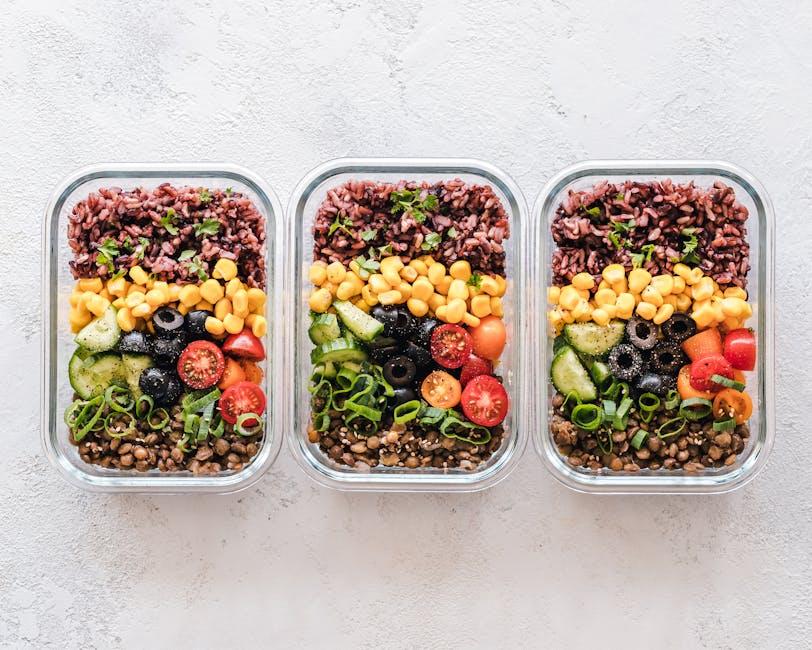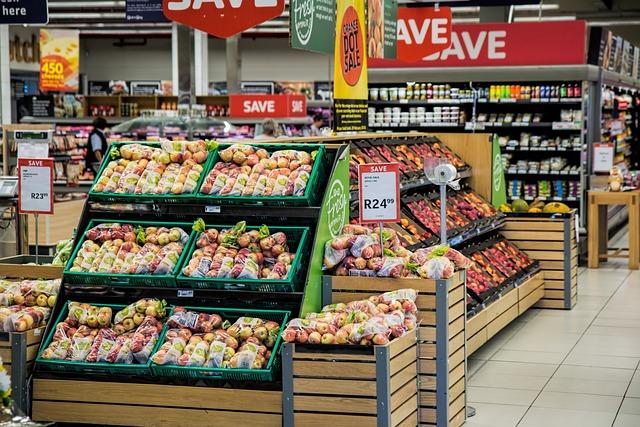Table of Contents
- Exploring Budget-Friendly Ingredients for Flavorful Meals
- Creative Cooking Techniques to Maximize Flavor on a Budget
- Meal Planning Strategies for Affordable and Nutritious Dishes
- Navigating the Grocery Store for Cost-Effective Food Choices
- Delicious Recipes That Wont Break the Bank
- Q&A
- To Conclude


Exploring Budget-Friendly Ingredients for Flavorful Meals
Cooking delicious meals on a budget doesn’t mean sacrificing taste. By focusing on budget-friendly ingredients, you can whip up flavorful dishes that please both the palate and the wallet. Ingredients like lentils, canned tomatoes, and brown rice are not only inexpensive but also incredibly versatile. For instance, lentils can be used in soups, stews, and salads, while canned tomatoes serve as a base for sauces and hearty casseroles. Additionally, brown rice is a staple that can accompany various main dishes or be turned into stir-fries with seasonal vegetables.
Another great way to keep costs down is by integrating seasonal produce into your meals. Visiting local farmers’ markets or looking for produce on sale can provide you with fresh, flavorful options. Consider using ingredients such as carrots, zucchini, and potatoes, which tend to be affordable and can be roasted, mashed, or sautéed. Furthermore, bulk buying items like onions, garlic, and frozen vegetables can enhance your meals while maintaining a tight budget.
When planning your meals, think about incorporating pantry staples to create robust flavors without breaking the bank. Consider using ingredients such as:
- Spices: Invest in basic spices like cumin, paprika, and oregano to elevate your dishes.
- Eggs: A brilliant source of protein that can be used across meals, from breakfast to dinner.
- Beans: Affordable powerhouses that can be added to salads, tacos, and chili for a hearty boost.
To easily compare cost-effective options, here’s a simple overview of common ingredients and their budget-friendly counterparts:
| Ingredient | Budget-Friendly Alternative |
|---|---|
| Chicken Breast | Canned Tuna |
| Fresh Herbs | Dried Herbs |
| Quinoa | Rice |
By opting for these ingredients and being creative with your cooking methods, you can create meals that are not only tasty but also easy on the budget.


Creative Cooking Techniques to Maximize Flavor on a Budget
When it comes to enhancing flavor without breaking the bank, experimenting with cooking techniques can lead to impressive results. One of the most effective methods is roasting vegetables. This technique caramelizes the natural sugars, converting the humble carrot or potato into a sweet and savory delight. Simply toss your favorite veggies in a bit of olive oil and seasonings, and roast until golden brown. For an added boost, try drizzling them with balsamic reduction or a squeeze of lemon juice right before serving.
Another technique to consider is creating homemade stocks from kitchen scraps. By saving vegetable peels, bones, and other leftovers, you can simmer them into a rich stock that can be the backbone of soups, stews, and sauces. This not only maximizes flavor but also reduces waste, reinforcing a sustainable approach to cooking. Pair your homemade stock with cut herbs, which you can freeze in ice cube trays for easy access. This allows you to add a burst of flavor to your meals without the expense of purchasing fresh herbs regularly.
don’t underestimate the power of influential marinades. A simple mix of soy sauce, garlic, and some acid like vinegar or citrus can elevate your proteins, turning inexpensive cuts of meat or beans into flavorful main dishes. Let your ingredients soak for a few hours or overnight to allow the flavors to penetrate deeply. Here’s a quick reference on how to create various marinades:
| Base Ingredient | Acid | Flavor Enhancer |
|---|---|---|
| Soy Sauce | Rice Vinegar | Ginger |
| Olive Oil | Lemon Juice | Garlic |
| Yogurt | Lime Juice | Cumin |


Meal Planning Strategies for Affordable and Nutritious Dishes
Effective meal planning can be a game-changer for those looking to eat well without breaking the bank. Start by creating a weekly meal schedule, allowing you to see the bigger picture of your nutrition for the week. This helps in reducing impulse purchases and ensures that you make the most of every ingredient you buy. Additionally, consider batch cooking; preparing larger portions of meals can save both time and money during the busy workweek.
Next, focus on using affordable staple ingredients that can form the base of multiple meals. Incorporate whole grains like rice, quinoa, or oats, and a variety of seasonal vegetables to enhance flavor and nutrition without skyrocketing your grocery bill. Beans and lentils not only pack a nutritional punch but also come at a fraction of the cost. When grocery shopping, keep your eyes peeled for sales, coupons, and bulk buying options, which can make a significant difference over time.
Lastly, don’t underestimate the power of creativity in the kitchen. Challenge yourself to create meals from what you already have at home. Take inventory of your pantry and fridge, and try to incorporate leftovers or near-expiry items into your weekly plan. You might be surprised at how many delicious meals you can concoct from what might otherwise go to waste. Here’s a quick look at how simple ingredient swaps can make a big difference:
| Original Ingredient | Budget-Friendly Swap |
|---|---|
| Chickpeas | Canned beans |
| Fresh herbs | Dried herbs |
| Chicken breast | Thighs or drumsticks |
| Quinoa | Rice |


Navigating the Grocery Store for Cost-Effective Food Choices
When stepping into a grocery store, your mission is to find food that aligns with both your budget and nutritional needs. To get started, take a moment to plan your shopping trip. Creating a shopping list based on meal ideas not only keeps you focused but also prevents impulse buys. Consider taking advantage of weekly sales and coupons; these can lead to significant savings on your favorite items. Remember to check your pantry and fridge before you go to avoid purchasing unnecessary duplicates.
As you navigate the aisles, prioritize shopping in the perimeter of the store. Fresh produce, dairy, and proteins tend to be found along the outer edge, while processed and packaged foods are often placed in the middle aisles. Opt for seasonal fruits and vegetables which are typically more affordable and taste better. Additionally, exploring store brands can save you money without sacrificing quality. Often, these brands offer products identical to name brands at a fraction of the cost.
Before you checkout, take a moment to examine bulk options. Often, purchasing items like grains, legumes, and nuts in larger quantities can result in lower prices per serving. Here’s a simple table to illustrate some cost-effective staples:
| Item | Cost per Serving | Benefits |
|---|---|---|
| Brown Rice | $0.20 | High in fiber and minerals |
| Lentils | $0.15 | Rich in protein and iron |
| Frozen Vegetables | $0.50 | Nutrient-preserved and versatile |
Incorporating these cost-saving strategies into your grocery shopping not only helps stretch your dollar but also sets the stage for healthier eating habits. The key lies in making smarter choices and being aware of store layouts, which can lead to both a fuller pantry and a happier wallet.


Delicious Recipes That Wont Break the Bank
Eating well doesn’t have to mean spending a fortune. With a bit of creativity and planning, you can whip up delicious meals that are both satisfying and easy on the wallet. Here are some cost-effective ideas:
- One-Pot Pasta Dishes: Simply toss your favorite pasta, seasonal vegetables, and a protein source like canned beans or leftover chicken into one pot. Add broth or water, season, and let it cook. This method minimizes both time and clean-up!
- Stir-Fried Rice: Perfect for using up leftovers, combine rice with whatever vegetables and proteins you have on hand. A splash of soy sauce or a sprinkle of sesame oil elevates the dish without a hefty price tag.
- Vegetable Soups: A base of onions and garlic, combined with vegetables and broth, creates a nutritious and comforting meal. Pair it with crusty bread for a wholesome dinner that stretches your food budget.
Incorporating pantry staples can also dramatically reduce costs. Consider meal prepping to save both time and money during the week. Here’s a quick overview of budget-friendly ingredients:
| Ingredient | Cost (approx.) | Uses |
|---|---|---|
| Rice | $1.00/lb | Stir-fries, casseroles, side dishes |
| Canned Beans | $0.75/can | Salads, stews, tacos |
| Frozen Vegetables | $2.00/bag | Soups, stir-fries, pastas |
Utilizing seasonal produce can also make a significant difference in your grocery bill. Visit local farmers’ markets or grocery stores to find what’s in season, as these items are often more affordable and fresher. Here’s a list of some versatile and budget-friendly veggies:
- Carrots: Great raw, roasted, or incorporated into stews.
- Zucchini: A perfect addition to stir-fries and pasta dishes.
- Potatoes: A filling base for many meals, whether baked, mashed, or roasted.
Q&A
Q&A: Navigating the World of Budget Good Food
Q1: What is “budget good food”? A: Budget good food refers to nutritious and delicious meals that can be made without breaking the bank. It focuses on using affordable ingredients while ensuring that the meals are satisfying and healthy.Q2: How can I eat well on a tight budget? A: Eating well on a budget starts with strategic planning. Shopping in season, buying in bulk, and opting for generic brands can significantly cut costs. Additionally, focusing on whole foods like grains, legumes, and seasonal vegetables helps create nutritious meals.Q3: Can I still make tasty meals without using expensive ingredients? A: Absolutely! Many affordable ingredients, such as beans, lentils, rice, and frozen vegetables, can create hearty and flavorful dishes. Utilizing herbs and spices can also elevate the taste of budget-friendly items, turning them into something special.Q4: What are some easy recipes for budget good food? A: Here are a few simple yet delicious recipes to consider:- Vegetable Stir-Fry: Quickly sauté seasonal vegetables in a bit of oil and soy sauce, served over rice or noodles.
- Chili: Combine canned beans, tomatoes, and spices for a filling meal that’s perfect for leftovers.
- Omelets: Use eggs as a base and fill with whatever vegetables and cheese you may have on hand.




0 Comments